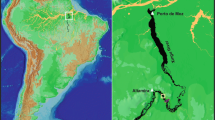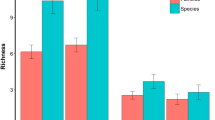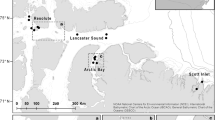Abstract
Over 400 sites were sampled in the nearshore of the U.S. Great Lakes during the U.S. National Coastal Condition Assessment (NCCA) field survey in summer 2010. Underwater video images were recorded in addition to routine NCCA benthic assessment measures. This paper has two objectives: (1) to develop a process to evaluate video performance with acceptance criteria, exploring reasons for poor images, and (2) to use acceptable videos in an example application with invasive mussels, evaluating the enhancement potential of video to supplement traditional grab sampling. A standard hierarchical protocol was developed to rank video performance based on quality and clarity. We determined controllable and uncontrollable factors affecting video performance. Moreover, specific thresholds limiting video were identified: >0.5/m for light extinction and >3.5 µg/L for chlorophyll a concentration. To demonstrate the utility and enhancement potential of video sampling, observed dreissenid presence from excellent (221 of 362 videos) videos was compared with NCCA benthic taxonomy, in the context of the statistically based NCCA survey. Including video increased the overall area estimate of the U.S. Great Lakes nearshore with invasive mussels by about 15 % compared to PONAR alone; 44 % (7570 km2) of the surveyed region had mussels. The proportion of the nearshore area having mussels varied from low (3.5 %) in Lake Superior to >50 % in the lower lakes. PONAR and video have unique strengths and weaknesses as sampling tools in the Great Lakes nearshore environment, but when paired were complimentary and thus provided a more thorough benthic condition assessment at lake and regional scales.








Similar content being viewed by others
References
Auer AT, Tomlinson LM, Higgins SN, Malkin SY, Howell ET, Bootsma HA (2010) Great lakes Cladophora in the 21st century: same algae–different ecosystem. J Great Lakes Res 36:248–255
Bertram P, Shear H, Stadler-Salt N, Horvatin P (2003) Environmental and socioeconomic indicators of great lakes basin ecosystem health. In: Rapport D, Lasley W, Rolston D, Nielsen N, Qualset C, Damania A (eds) Managing for healthy ecosystems. CRC Press, Lewis Publishers, Boca Raton, pp 703–720
Caraco NF, Cole JJ, Raymond PA, Strayer DL, Pace ML, Findlay SEG, Fischer DT (1997) Zebra mussel invasion in a large, Turbid river: phytoplankton response to increased grazing. Ecology 78(2):588–602
Coakley TP, Brown GL, Ioannou SE, Charlton MN (1997) Colonization patterns and densities of Zebra Mussel Driessena in muddy offshore sediments of western Lake Erie, Canada. Water Air Soil Pollut 99:623–632
Custer CM, Custer TW (1997) Occurrence of Zebra Mussels in near-shore areas of western Lake Erie. J Great Lakes Res 23:108–115
Environment Canada and Unites States Environmental Protection Agency (2009) Nearshore areas of the great lakes 2009, State of the Lakes Ecosystem Conference 2008 Background Paper. ISBN 978-1-100-13562-5. EPA 905-R-09-013, Cat. No. En164-19/2009E
Grigorovich IA, Kelly JR, Darling JA, West CW (2008) The Quagga Mussel invades the lake superior basin. J Great Lakes Res 34:342–350
Hecky RE, Smith REH, Barton DR, Guildford SJ, Taylor WD, Charlton MN, Howell T (2004) The nearshore phosphorus shunt: a consequence of ecosystem engineering by Dreissenids in the Laurentian great lakes. Can J Fish Aquat Sci 61(7):1285–1293
Hewitt JE, Thrush SF, Cummings VJ, Turner SJ (1998) The effect of changing sampling scales on our ability to detect effects of large-scale processes on communities. J Exp Marine Biol Ecol 227:251–264
Holland RE (1993) Changes in planktonic diatoms and water transparency in Hatchery Bay, Bass Island Ares, Western Lake Erie since the establishment of the Zebra Mussel. J Great Lakes Res 19(3):617–624
Howell ET, Marvin CH, Bilyea RW, Kauss PB, Somers K (1996) Changes in environmental conditions during Dreissena colonization of a monitoring station in Eastern Lake Erie. J Great Lakes Res 22(3):744–756
Kincaid TM, Olsen AR (2012) spsurvey: Spatial Survey Design and Analysis. R package version 2.5. http://www.epa.gov/nheerl/arm/
Klerks PL, Fraleigh PC, Lawniczak JE (1996) Effects of zebra mussels (Dreissena polymorpha) on seston levels and sediment deposition in western Lake Erie. Can J Fish Aquat Sci 53:2284–2291
Mackey SD, Goforth RR (Guest Editors) (2005) great lakes nearshore habitat science. J Great Lakes Res 31(Supplement 1):1–5
Nalepa TF, Quigley NA, Ziegler RW (1988) Sampling efficiency of the PONAR grab in two different benthic environments. J Great Lakes Res 14(1):89–93
Nicholls KH, Hopkins GJ (1993) Recent changes in lake Erie (North Shore) phytoplankton: cumulative impacts of phosphorus loading reductions and the zebra mussel introduction. J Great Lakes Res 19(4):637–647
Niemi GJ, Kelly JR (Guest Editors) (2007) Special issue on coastal indicators. J Great Lakes Res 33(Special Issue 3):1–320
Ozersky T, Malkin SY, Barton DR, Hecky RE (2009) Dreissenid phosphorus excretion can sustain C. Glomerata growth along a portion of lake Ontario Shoreline. J Great Lakes Res 35:321–328
Ozersky T, Barton DR, Depew DC, Hecky RE, Guildford SJ (2011) Effects of water movement on the distribution of invasive dreissenid mussels in lake simcoe, Ontario. J Great Lakes Res 37:46–54
Powers CF, Robertson A (1967) Design and evaluation of an all-purpose benthos sampler. In: Ayers JC, Chandler CC (eds) Studies on the environment and eutrophication of lake Michigan. University of Michigan, Great Lakes Research Division Special Report 30, pp 179–187
Schaner T, Fox MG, Taraborelli AC (2009) An inexpensive system for underwater video surveys of demersal fishes. J Great Lakes Res 35:317–319
Shear H, Stadler-Salt N, Bertram P, Horvatin P (2003) The development and implementation of indicators of ecosystem health in the great lakes Basin. Environ Monit Assess 88:119–152
Snedecor GW, Cochran WG (1967) Statistical methods, 6th edn. The Iowa State University Press, Ames
SOLEC (1996) State of the lakes ecosystem conference, Nov 6–8, 1996, Windsor, ON. http://www.on.ec.gc.ca/solec/solec96-description.html
Spink J, Read L (2011) Freshwater lens camera system surveys seafloor in high-turbidity waters. Sea Technology. Compass Publications Inc, Virginia, pp 39–43
Stevens DL, Olsen AR (2003) Variance estimation for spatially balanced samples of environmental resources. Environmetrics 14:593–610
Stevens DL, Olsen AR (2004) Spatially balanced sampling of natural resources. J Am Stat Assoc 99(465):262–278
U.S. EPA (1992) Great lakes monitoring and research strategy. EPA/620/R-92/001. U.S. Environmental Protection Agency, Washington, DC
U.S. EPA (2001a) National coastal assessment: field operations manual. U. S. Environmental Protection Agency, Office of Research and Development, National Health and Environmental Effects Research Laboratory, Gulf Ecology Division, Gulf Breeze, FL EPA 620/R-01/003
U.S. EPA (2009a) National coastal condition assessment: field operations manual. EPA-841R-09-003. U.S. Environmental Protection Agency, Washington, DC
U.S. EPA (2009b) National coastal condition assessment: laboratory methods manual. EPA No. 841-R-09-002. U.S. Environmental Protection Agency, Washington, DC
U.S. EPA (2012) National coastal condition report IV. EPA-842-R-10-003. Office of Research and Development/Office of Water. Washington, DC
United States and Canada (2012) Great lakes water quality agreement of 2012. September 07, http://www.epa.gov/glnpo/glwqa/
Van Rein HB, Brown CJ, Quinn R, Breen J (2009) A review of sublittoral monitoring methods in temperate waters: a focus on scale. Int J Soc Underwater Technol 28(3):1–15
Wilson KA, Howell ET, Jackson DA (2006) Replacement of Zebra Mussels by Quagga mussels in the Canadian nearshore of lake Ontario: the importance of substrate, round goby abundance, and upwelling frequency. J Great Lakes Res 32:11–28
Acknowledgments
We thank scientists at the U.S. EPA Office of Research and Development—specifically, Will Bartsch (ORISE Participant) and Tim Corry at the Mid-Continent Ecology Division (Duluth), Tony Olsen and Tom Kincaid at the Western Ecology Division (Corvallis), and John Kiddon at the Atlantic Ecology Division (Narragansett)—for support on various aspects of the frame development, survey design, field pilot survey and camera testing, and crew training. Many of these folks generously offered assistance with some aspect of data management and analysis, including statistical summaries/analysis of this initial NCCA for the Great Lakes. John Kiddon performed the K d calculations for the Great Lakes data presented here. John McCauley at the Gulf Ecology Division (Gulf Breeze, FL) Greg Collianni (OW), and Tony Olsen were critical, helping to motivate and include the NCCA-Great Lakes effort. We thank EPA’s Office of Water (OW), specifically Greg Collianni, Sarah Lehmann, Treda Grayson, and Hugh Sullivan, as well as their OW Contractors, and numerous staff from the Great Lakes States who coordinated and/or conducted the extensive field sampling in 2010, including collection of the video images. Contractors to OW completed the taxonomic analyses and water quality analyses we used for comparison with video results. Mari Nord at EPA Region 5 has been a great liaison between ORD research efforts and the collection/use of the data by Great Lakes States in Regions 2, 3, and 5. Paul Horvatin, Paul Bertram, Glenn Warren, and Beth Hinchey Malloy at the Great Lakes National Program Office (GLNPO)/Region 5 were instrumental in helping to develop and maintain the relationship between ORD, the Regions, OW and the States as a strong partnership to adopt the NCCA approach in surveying the Great Lakes nearshore; they also were key in securing Great Lakes Restoration Initiative funding to make possible the Great Lakes 2010 enhancements, including the underwater video tool evaluated here. Beth kindly offered review comments of a draft of the manuscript. Julie (Barker) Lietz was an ORISE participant at EPA, during which she conducted the video analysis and developed the standard processing/rating protocols presented in this study. This work was supported in part by an appointment to the ORISE participant research program supported by an interagency agreement between EPA and DOE (IA 92298301); the views expressed in this paper are those of the authors and do not necessarily reflect the views or policies of the U.S. EPA.
Author information
Authors and Affiliations
Corresponding author
Rights and permissions
About this article
Cite this article
Lietz, J.E., Kelly, J.R., Scharold, J.V. et al. Can a Rapid Underwater Video Approach Enhance the Benthic Assessment Capability of the National Coastal Condition Assessment in the Great Lakes?. Environmental Management 55, 1446–1456 (2015). https://doi.org/10.1007/s00267-015-0475-3
Received:
Accepted:
Published:
Issue Date:
DOI: https://doi.org/10.1007/s00267-015-0475-3




